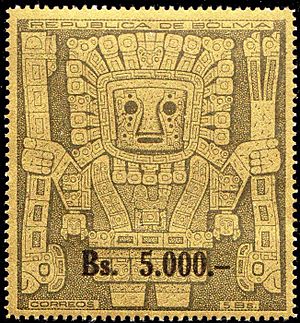Staff God facts for kids

In ancient Andean art, figures that face forward are often called Staff Gods. People believe these figures show gods from different Andean cultures. There isn't just one way to show a Staff God. Many different versions exist. Usually, a Staff God faces forward and holds a tall object, like a "staff," in each hand. Some experts think certain Staff God images might show gods like Viracocha or Thunupa.
The oldest known picture of a Staff God was found in 2003. It was on pieces of a broken gourd in a burial site. This site was in the Pativilca River Valley in the Norte Chico area. Scientists used carbon dating and found it was from 2250 BCE. This makes it the oldest image of a god ever found in the Americas.
Some experts believe the Wari-Tiwanaku Staff God was a very early version of the main Inca gods. These Inca gods included the Sun, Moon, and Thunder. As a chief god, the Staff God was seen as the creator. It was a very important religious symbol across the Peruvian Andes. This was especially true during the Early Horizon period (900-200 BC) and later. The worship of Staff Gods spread throughout the Central Andes. This happened during the Middle Horizon period (600-1000 CE). Many items found from this time look like the Staff God.
What the Staff God Looks Like
The Staff God was a common image in the ancient cultures of Peru. This was especially true for groups living on the northern coast and in the southern highlands. The art styles were very similar, which shows that many people believed in this god.
The Staff God was shown in different ways by these Andean cultures. But it was often pictured as a powerful god. Its hands always held objects that showed its power. For example, an ancient object found at Chavin de Huantar shows the god holding shells. These were Spondylus and Strombus shells. They were symbols for female and male. This image showed that the Staff God had the power to keep society balanced. It also showed the Andean idea of gender balance.
Another famous stone carving from the Early Horizon is the Raimondi Stele. It shows the Staff God as a sky or lightning god. This god appears to be coming down to Earth.
Staff God in Art
In the southern highlands, images of the Staff God were not just symbols. They also appeared with other gods. These were painted on fabrics used to decorate temple walls. They were also painted on ceramic pots.
The Staff God is one of the most important images in ancient Andean history. It appears in many types of art. You can see it in stone, on textiles, and on pottery. For example, a form of the Staff God is central to the Sun Gate of the Tiwanaku culture. This gate is a huge stone carving. Tunics (shirts) and pottery from both the Tiwanaku and Wari cultures show a similar god. These are from the Middle Horizon period. Another example is the giant offering jars found at Qunchupata. They were painted with the Staff God's image. This image looks like the god shown on the back of the Tiwanaku's Ponce Monolith.
See also
In Spanish: Dios de los báculos para niños

